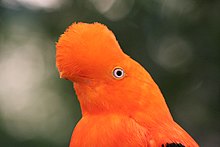Rock cocks
| Rock cocks | ||||||||||||
|---|---|---|---|---|---|---|---|---|---|---|---|---|

Lowland rock cock ( Rupicola rupicola ), |
||||||||||||
| Systematics | ||||||||||||
|
||||||||||||
| Scientific name | ||||||||||||
| Rupicola | ||||||||||||
| Brisson , 1760 |

The rock cocks or cliff birds ( Rupicola ) are a genus from the family of ornamental birds (Cotingidae), which consists of two species:
- the lowland rock cock or orange rock cock, Guyana cliff bird or cayenne cliff bird ( Rupicola rupicola ( Linnaeus 1766)) and
- the Andean cliff bird or red rock cock ( Rupicola peruviana ( Latham 1790)).
features
Rock cocks have a stocky build and extraordinarily strong feet. The males have extremely bright plumage with a wide, fan-shaped tuft that extends over the head and almost completely covers the beak. The female birds are less conspicuously colored, the forelock is significantly smaller.
The male orange rock cock is about the size of a pigeon, 32 to 35 cm long and bright orange in color. The wings are black with white mirrors, the outer flags form long orange threads. The tail is chocolate brown and tapering off in orange. The female is olive-gray in color, the tail and wings are brown, only the coverts are light orange.
At 35 to 38 cm, the male of the red rock cock is slightly larger than the red rock cock, mainly because of the longer tail feathers. There are two subspecies: Rupicola peruviana aequatorialis is deeply orange, the female is orange-brown, the male of Rupicola peruviana sanguiolenta is scarlet, the female is dark chestnut red .
Occurrence
Rock cocks live in the tropical and subtropical jungle of South America, preferably in mountainous and water-rich areas such as the headwaters of the Orinoco and Amazon . The orange rock cock is found in Guyana , southern Venezuela and the Rio Negro area. The red cliff cock in western Venezuela and along the Andes to Ecuador , Peru and northern Bolivia .
Behavior and reproduction
During the courtship season, rock cocks gather in open spaces near the rocks, which they free from twigs. Several male birds perform dances for the watching females, which consist of short steps and jumps, accompanied by typical vocalizations.
Rock cocks prefer to nest on elevated spots in rocky terrain. The nest is flat and bowl-shaped and is built in crevices or directly on the rock from twigs and clay and covered with leaves on the outside. Most of the two eggs are spotted brown and are incubated by the females alone.
proof
- The modern animal lexicon. Bertelsmann Publishing Group, Volume 3, 1981
